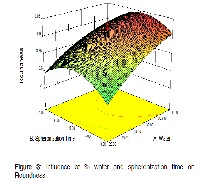Formulation and multivariate optimization of microcrystalline cellulose pellets of highly water soluble drug
Keywords:
Microcrystalline Cellulose, Pelletization, Central composite Design, Response Surface MethodologhyAbstract
Microcrystalline Cellulose (MCC) pellets containing highly water soluble compound A was formulated with highest pellet usable yield of 86%, aspect sphericity that is (aspect ratio less than 1.1 and roundness greater than 0.85), minimum friability of 0.33% by extrusion and Spheronization technique. A Central Composite Design (CCD) was executed to estimate the effect of formulation and process variable namely water (21-41%), spheronization time (1-9 min) and Spheronization speed (200-800) to maximize responses i.e, usable yield, Sphericity aspect ratio and roundness. Least square regression analysis using response surface methodology permit the identification and optimization of variables that shows significant effect on selected responses. Polynomial model fitted to the data were used to predict the responses in the desired value. A generalized desirability function is used to get maximum achievable target for responses. The optimum values for variables were water 31%, Spheronization Time of 5 min and Spheronization speed of 500 rpm. These results confirmed the usefulness of Multivariate analysis to identify the critical variables and their interactions on the characteristics of pelletization
References
Sinha VR, Agrawal MK and Kumria R. Influence of Formulation and Excipient Variables on the Pellet Properties, Prepared by Extrusion Spheronization. Current Drug Delivery. 2005; 2: 1-8.
Mehta KA, Kislalioglu MS, Phuapradit W, Malick AW, Shah NH. Effect of formulation and process variables on porosity parameters and release rates from a multi unit erosion matrix of a poorly soluble drug. J Control Release. 2000; 63:201-211.
Kojima M, Nakagami H. Development of controlled release matrix pellets by annealing with micronized water-insoluble or enteric polymers. J Control Release. 2002; 82: 335-343.
Elchidana PA, Deshpande SG. Microporous membrane drug delivery system for indomethacin. J Control Release. 1999; 59: 279 - 285.
Fekete R, Zelko R, Marton S, Racz I. Effect of the formulation parameters on the characteristics of pellets. Drug Dev. Ind. Pharm, 1998; 24: 1073-1076.
Ghebre- Shellasie I. Pellets: a general overview. In: Ghebre- Shellasie I, ed. Pharmaceutical Pelletization Technology. New York, NY: Marcel Dekker Inc; 1989: 6-7.
Rekki, G. S., Porter, S.C. and Jambhekar, S.S., .Factors affecting the Release of Propranolol Hydrochloride from Beads Coated with Aqueous Polymeric Dispersions. Drug Dev. Ind. Pharm. 1995; 21: 709.
Gandhi, R., Kaul, C.L. and Panchagnula, R..Extrusion and spheronization in the development of oral controlled-release dosage forms. Pharm Sci Tech Today. 1999; 2: 160.
Schmidt C and Kleinebudde P. Influence of the Granulation Step on Pellets Prepared by Extrusion/Spheronization. Chem. Pharm. Bull. 1999; 47(3): 405-412
Thoma K and Ziegler I. Investigations on the Influence of the Type of Extruder for Pelletization by Extrusion-Spheronization. I. Extrusion Behavior of Formulations. Drug Deve. Ind. Pharm. 1998; 24: 401 - 411
Koo OMY, Heng PWS. The influence of microcrystalline cellulose grade on shape and shape distributions of pellets produced by extrusion-spheronization. Chem Pharm Bull (Tokyo). 2001; 49: 1383-1387
Neau S. H., Chow M. Y., Durrani M. J. Fabrication and characterization of extruded and spheronized beads containing Carbopol 974P, NF resin. International Journal of Pharmaceutics. 1996; 131: 47-55.
Neau S. H., Chow M. Y., Hileman G. A., Durrani M. J., Gheyas F., Evans B. A. Formulation and process considerations for beads containing Carbopol 974P, NF resin made by extrusion- spheronization. International Journal of Pharmaceutics 2000; 199: 129-140.
Gouldson MP, Deasy PB. Use of cellulose ether containing excipients with microcrystalline cellulose for the production of pellets containing metformin hydrochloride by the process of extrusion-spheronization. J Microencapsul. 1997; 14: 137-153.
Agrawal AM, Howard MA, Neau SH. Extruded and spheronized beads containing no microcrystalline cellulose: influence of formulation and process variables. Pharm Dev Technol. 2004; 9: 197-217.
Rowe RC, Sheskey PJ and Owen SC, Handbook of Pharmaceutical Excipients, 5th edition, Published by the Pharmaceutical Press; 2006. p. 132-135, 389-395, 449-453, 96-99, 731-733, 336-340, 611-615
Seth AK and Misra AN. Mathematical modeling of preparation of acyclovir liposomes: Reverse phase evaporation method. J. Pharm. Pharm. Sci. 2002; 5: 285-291
Sanchez-Lafuente C, Furlanetto S and Fernandez-Arevalo M. Didanosine extended-release matrix tablets: optimization of formulation variables using statistical experimental design. Int. J. Pharm. 2002; 237: 107-118
Boza A, De la Cruz Y, Jordan G, Jauregui-Haza U, Aleman A and Cataballo I. Statistical optimization of a sustained release matrix tablet of lobenzarit disodium. Drug Dev. Ind. Pharm. 2000; 26: 1303-1307





